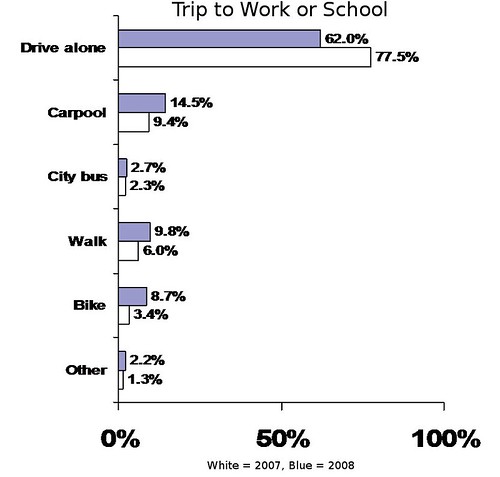Getabout Columbia data: Funding bicycling and walking really does work
Submitted by Brent Hugh on Thu, 04/02/2009 - 7:09am

Columbia, MO, Transportation Changes, Trip to Work or School, 2007 to 2008
The nonmotorized pilot projects, in four locations across the U.S., were designed to test whether or not spending relatively small amounts of transportation money on bicycling and walking could help solve the real, very difficult transportation problems facing our country, including congestion and pollution.
Experience in many other countries has shown that creating a good, complete, safe bicycling and walking transportation system is a very cost-effective transportation strategy.
But will it work in America?
Will it work in Missouri?
Based on the preliminary data we've seen--the results of just one year's worth of relatively minor and inexpensive changes in Columbia--the answer is a resounding yes.
A survey was made of about 400 Columbia citizens by phone in 2007 (before any changes were made) and then again a year later. The most interesting question was, "How do you get to school or work in a typical week?"
The results are summarized in the attached graphic.
Solo automobile use is down over 15 percentage points, walking is 1.6 times what it was 12 months ago and bicycling is 2.5 times what it was 12 months ago.
Other interesting facts, from an on-street count and survey of bicyclists and pedestrians:
* The percentage of utilitarian bicycling went from 31% in 2007 to over 50% in 2008.
* Pedestrians outnumber bicyclists, but bicyclists travel further. The result is that both groups travel almost exactly the same number of miles total (589 pedestrians traveled an average of 2.1 miles or 1240 miles total; 187 bicyclists traveled an average of 6.6 miles or 1227 miles total)
And you have to realize that the GetAbout Columbia project is really just getting started--these dramatic changes came as a result of:
* A one year program of the education, encouragement, marketing, promotion of bicycling and walking
* Approximately 7 new miles of bicycle lanes (for a total of 25 miles) and 10 new miles of marked bicycle routes (for a total of 28 miles)--completed about halfway through the year
* A few minor tweaks to some intersections, such as marking the spot where bicycles will trigger the light to change
And we're likely to see further dramatic improvements in the next few years as more of the GetAbout trails, sidewalks, bicycle routes, and improved intersections are rolled out.
In the grand scheme of Columbia's overall transportation system--some hundreds of miles of roads and bridges worth many hundreds of millions of dollars--these changes are pretty small and inexpensive.
It's quite amazing that such small, inexpensive steps show such large results so soon.
And we're likely to see further dramatic improvements in the next few years as more of the GetAbout trails, sidewalks, bicycle routes, and improved intersections are rolled out.
That's what we've seen in cities like Portland--more bicycle/pedestrian infrastructure correlates directly with more bicycling and walking. And you see some results immediately but it takes several years for people's behavior and habits to fully change. So it takes some years for the full results to become apparent.
These first results from Columbia are very, very promising--and future results promise to be even better.
Tags:
- News
- bicycle
- bicycling
- columbia
- data
- funding
- getabout
- GetAbout Columbia
- illinois
- links
- missouri
- missouri bicycle federation
- Missouri Tourism
- pedestrian
- story
- walking
- Bicycle
- Business
- Columbia, South Carolina
- Cycling
- Environment
- Exercise
- Missouri
- Pedestrian
- Portland
- Portland, Oregon
- Recreation
- Segregated cycle facilities
- Sustainability
- Sustainable transport
- Transport
- transportation
- Transportation planning
Join MoBikeFed's Advocacy Network
MoBikeFed is a statewide group of people like you, working together for better bicycling, walking, and trails in Missouri. When you join our advocacy network you receive occasional important advocacy alerts and bicycle, pedestrian, and trails news from around Missouri.
Working together we make a real difference! Join our advocacy network:
Working together we make a real difference! Join our advocacy network:
Related pages
Current topics...
Archives...
Want better bicycling and walking in Missouri?
We rely on the support of members like you. Please join, renew, or donate today.
- Home
- JOIN/DONATE
- News/Info
- Missouri Bicycling, Running, Trails
- Bicycle Skills and Safety
- Missouri Bike/Ped Law
- Clubs and Organizations
- Bike Shops
- Running Shops
- Bicycling, Running, Trails-related Businesses
- Ride, Run, Walk, Hike, Triathlon, and Events Calendars
- Bicycles on Amtrak
- Maps and Routes
- Trails and Trail Maps
- IBikeMO.org
- Planning a Missouri bicycle trip
- Gravel and Bikepacking Maps & Routes
- Bicycle & Touring Routes
- Advocacy
- Campaigns
- Our Legislative Platform
- Complete Streets
- Statewide Rock Island Trail
- Statewide Trail Vision - Quad State Trail
- Bicycle Friendly Missouri
- Walk Friendly Missouri
- Safe Routes to School
- MoDOT funding crisis
- High Priority Bike/Ped Project List
- Anti-harassment laws in cities & statewide
- Updating the basic bicycle law
- Our Vision for MoDOT
- Our Vision for MPOs/RPCs
- Our Vision for Cities & Counties
- Bicycle, pedestrian, trails plans across MO
- Protecting Vulnerable Road Users
- Vision Zero
- Missouri Trail Towns
- Store
- About

